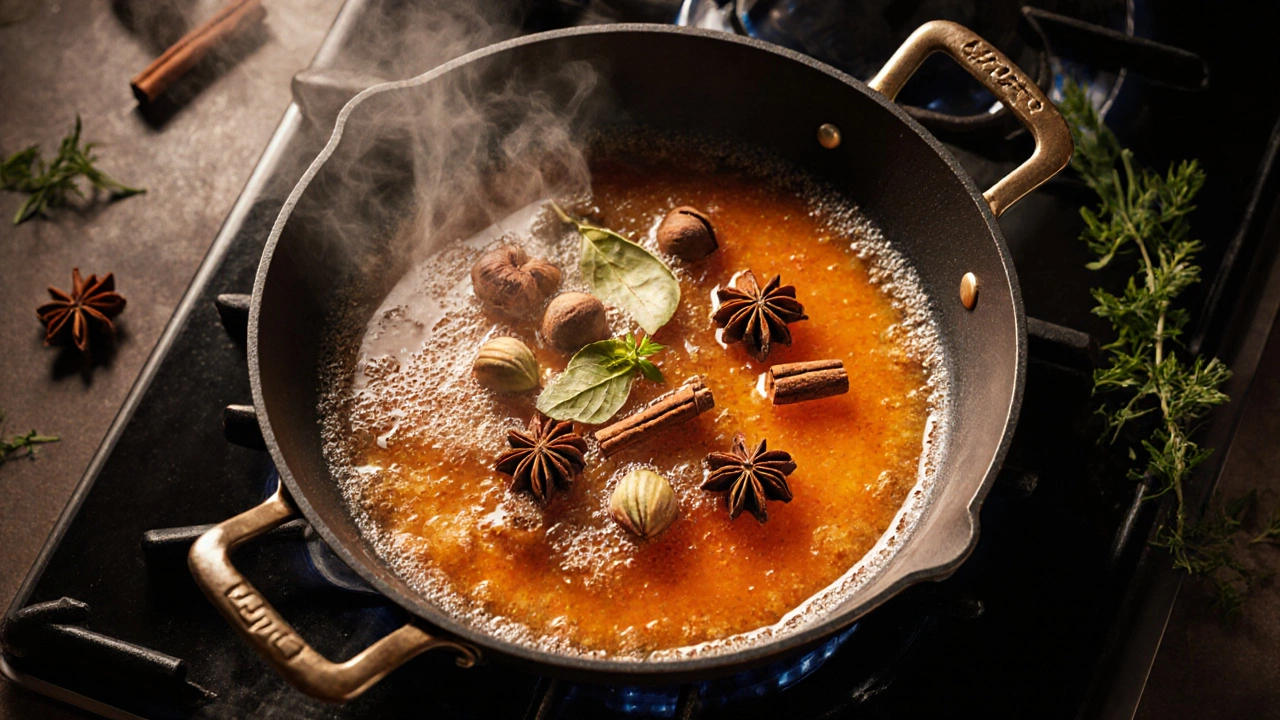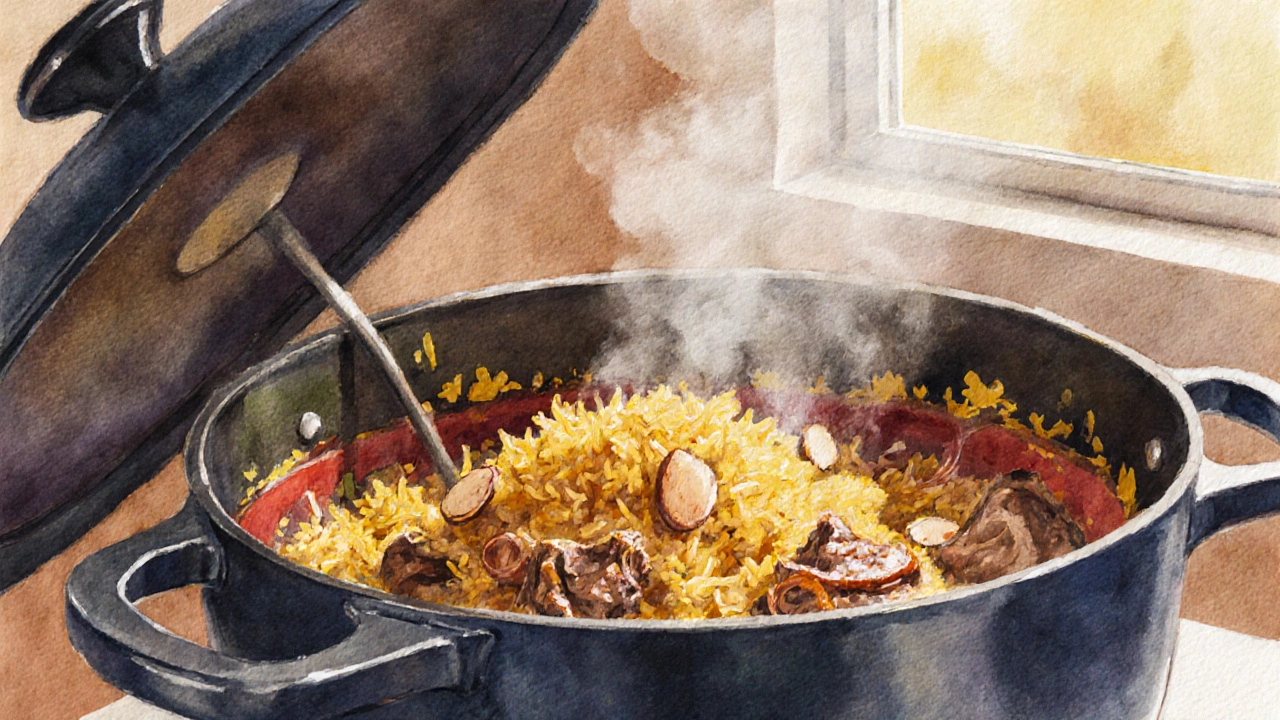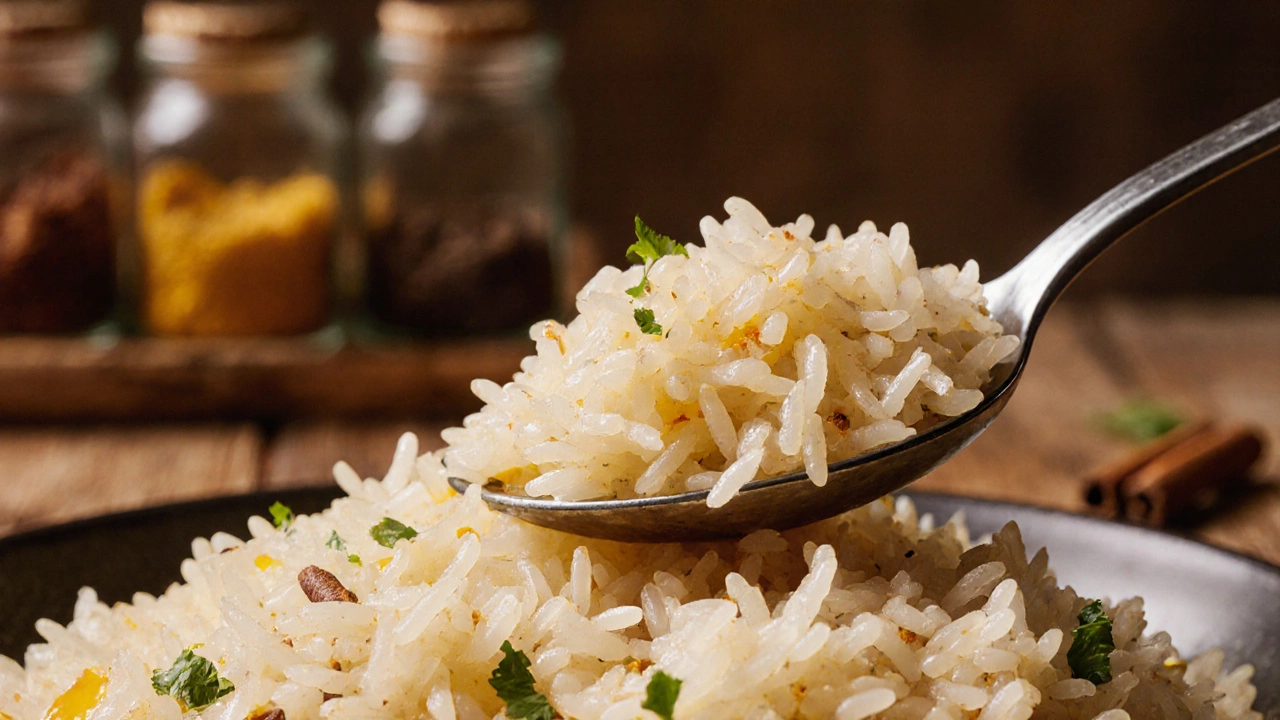Biryani Flavor Balance Calculator
Adjust heat level (0-10)
Tamarind/yogurt ratio (0-10)
Raisins/nuts ratio (0-10)
Ghee/oil ratio (0-10)
Flavor Balance Analysis
Ever wondered why a single spoonful of Biryani is a flavor explosion that leaves you reaching for more? The answer isn’t a mystery; it’s a mix of science, tradition, and a few clever tricks that generations of cooks have refined. Below we break down every element that makes biryani so tasty, from the rice grain to the final garnish.
The Foundation: Fragrant Basmati Rice
Basmati rice is a long‑grain variety with low amylose and a natural aroma of 2‑acetyl‑1‑pyrroline. When soaked and par‑boiled, each grain stays separate, creating a light, fluffy base that absorbs flavors without turning mushy. The slim shape also increases surface area, letting the spice‑infused oil coat every grain evenly.
Flavor Carriers: Ghee and Oil
Ghee is clarified butter that melts at a lower temperature than regular butter, allowing it to sear spices without burning. Its high smoke point releases buttery notes while locking in the volatile oils from the spices. Some cooks add a splash of neutral oil (like sunflower) to stretch the ghee and keep the dish from feeling too heavy.
Whole Spices - The Aromatic Backbone
Whole spices are toasted briefly before being ground or left whole for the “dum” (steam) stage. Classic biryani spices include:
- Cardamom - bright, citrusy notes that cut through richness.
- Cloves - warm, sweet‑spicy depth.
- Cinnamon sticks - woody sweetness.
- Bay leaves - subtle herbal aroma.
- Star anise - licorice‑like flavor.
When these spices are heated in ghee, they release essential oils that bloom, creating the foundational perfume of biryani.
Saffron & Color - More Than Looks
Saffron strands steeped in warm milk or water dissolve into a deep orange hue. Besides visual appeal, saffron adds a delicate earthy sweetness and a subtle metallic note that balances the heat from chilies.

Acidity and Sweetness: Tamarind, Yogurt, & Raisins
Balancing bright and sweet is crucial. Tamarind pulp provides tanginess that lifts the richness of meat and ghee. Yogurt used in marinades adds a mild sour note while tenderizing protein. A handful of Raisins or golden sultanas bring bursts of natural sweetness that contrast the spice heat.
Marination - Infusing Depth Early
Meat (chicken, mutton, or beef) is usually marinated in a mixture of yogurt, ginger‑garlic paste, chili powder, and the whole‑spice blend for at least an hour. This step allows the proteins to absorb flavor and stay juicy during the long cooking process.
Layering & Dum Cooking - The Secret Steam Trap
Dum cooking means sealing the pot with dough or a tight lid and cooking over low heat. The trapped steam circulates, allowing the rice to finish cooking in its own flavored vapor. Layering - rice, meat, fried onions, herbs, and saffron - creates pockets where each bite can hit multiple flavor zones.
Finishing Touches: Fried Onions, Nuts, and Fresh Herbs
Fried onions (birista) add crunchy sweetness and caramelized depth. Toasted almonds or cashews contribute a buttery crunch, while chopped cilantro and mint inject fresh herbal brightness right before serving.

Why It All Works Together - A Quick Cheat Sheet
| Component | Primary Role | Key Sensory Impact |
|---|---|---|
| Basmati rice | Base grain | Fluffy texture, absorbs aromatics |
| Ghee | Fat carrier | Rich buttery mouthfeel, lifts spice oils |
| Whole spices | Aroma foundation | Warm, spicy perfume |
| Saffron | Color & subtle sweetness | Earthy, luxurious note |
| Tamarind / Yogurt | Acidity | Brightness, cuts richness |
| Raisins / Nuts | Sweetness & texture | Contrast to spice heat |
| Fried onions | Sweet caramel | Depth, slight crunch |
Pro Tips to Boost the biryani taste
- Toast whole spices just until they start to pop - over‑browning makes them bitter.
- Use a heavy‑bottom pot (Dutch oven or pressure cooker) for airtight dum sealing.
- Let the assembled biryani rest off the heat for 10 minutes before opening - this lets flavors settle.
- For extra fragrance, sprinkle a pinch of freshly ground powdered cardamom on the final layer.
- Never stir the rice after the dum stage; disturbing layers releases steam and flattens flavors.
Common Pitfalls and How to Fix Them
- Rice too mushy: Reduce the initial boil time and ensure the pot is tightly sealed.
- Spice flavor missing: Increase toasting time or add a second round of whole spices directly to the dum layer.
- Dry texture: Add a splash of warm water or stock before sealing; the steam will re‑hydrate the grains.
- Over‑salty: Use low‑sodium broth in the rice and season the meat lightly during marination.
Wrapping Up
Great biryani isn’t magic; it’s the result of precise grain selection, balanced fat, layered aromatics, and a steam‑locked cooking method. Master each component, and you’ll consistently serve a dish that dazzles the palate.
Why does biryani need basmati rice specifically?
Basmati’s long, slender grains stay separate after cooking and carry the spice‑infused oil better than short‑grain varieties, giving biryani its characteristic fluffy texture.
Can I use regular butter instead of ghee?
You can, but ghee’s higher smoke point and nutty flavor make it superior for toasting spices without burning. Butter may introduce a milky taste and can scorch.
Is saffron essential for authentic biryani?
Saffron adds a signature color and delicate aroma, but a pinch of turmeric + a few strands of food‑grade orange coloring can mimic the look if saffron is unavailable.
How long should I marinate the meat?
At least 30 minutes for chicken; for tougher meats like mutton, aim for 2-4 hours in the refrigerator to ensure tenderness and flavor penetration.
What’s the best pot for dum cooking?
A heavy‑bottom Dutch oven or a thick‑walled pressure cooker with a sealing dough (atta) works best. The key is an airtight lid that traps steam.
